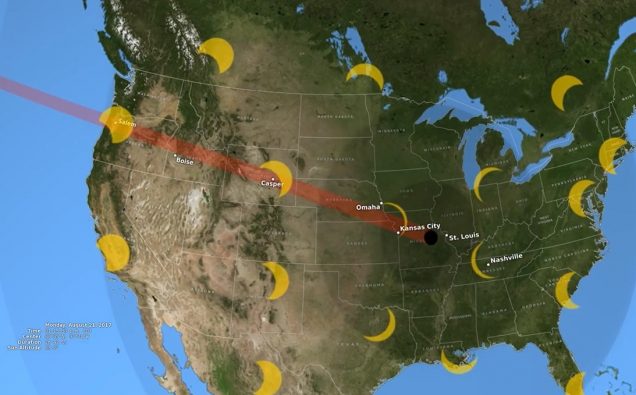
Photo: Screenshot of a NASA-posted view during the upcoming total solar eclipse of Aug. 21, 2017 Credit: NASA/Goddard Space Flight Center Scientific Visualization Studio
The excitement has been building up this month for Monday’s total solar eclipse which will last just over two minutes but offers a rare opportunity to view the eclipse from U.S. coast to coast.
The only thing that come in between the eclipse views will be the trains of clouds at some places.
But under clear skies it will be for the first time since 1918 that Americans all over the country would be able to witness the eclipse when the moon comes between the sun and the earth in a unique position, casting a shadow on earth.
However, astronomers and scientists are also advising people to be careful in watching the eclipse as even a small fraction of the sunrays not hidden during the eclipse as the naked eye could be exposed to ultraviolet or infrared light.
According to NASA, the total solar eclipse begins near Lincoln City, Oregon, at 10:15 a.m. PDT (1:15 p.m. EDT) and totality ends at 2:48 p.m. EDT near Charleston, South Carolina.
The partial eclipse will start earlier and end later, but the total eclipse itself will take about one hour and 40 minutes to cross the country, says the space agency which is hosting science projects that will occur during this unique period of time.
The space agency explains that solar eclipses occur when the moon blocks any part of the sun. Total solar eclipses, however, are only possible on Earth because of a cosmic quirk of geometry: The sun’s diameter is 400 times wider than the moon’s, but it is also 400 times farther away.
“The result is that the sun and the moon appear to be the same size from our perspective. When they line up just right, the moon can obscure the sun’s entire surface, creating a total solar eclipse. This line-up occurs once every 12 to 18 months. Partial solar eclipses, on the other hand, occur when the alignment is such that the moon blocks only part of the sun, and these can occur more frequently.”
The scientists will have the rare opportunity during the total eclipse to look directly at the sun’s vast, striking outer atmosphere, the corona.
“The corona appears as pearly white rays and streamers, radiating around the lunar disk. The August 2017 eclipse will present this exciting opportunity to millions across the entire country.”
As explained by NASA, it is in the corona that scientists observe giant solar eruptions like solar flares and coronal mass ejections, and the origin of the solar wind, the continuous flow of charged particles from the sun.
“All of these constantly shape the very nature of the space around Earth and other planets. Studying the corona and its role in the interconnected sun-space system is crucial for understanding not only the relationship between Earth and the sun, but also the space environment our satellites and astronauts must travel through for future exploration.
“There is a whole spectrum of colors of light that our eyes cannot see,” Habbal said. “From these different colors, we can directly probe into the physics of the corona.” Different colors provide unique information about the temperature and composition of solar material in the corona.
Anyone can witness the eclipse but Alex Young, a solar scientist at NASA’s Goddard Space Flight Center in Greenbelt, Maryland, and other experts favor eclipse safety.
Here is what NASA detailed in a news release about safely viewing the eclipse.
Even during an eclipse, it is not safe to look directly at the sun – except for the brief phase of totality, when the moon fully obscures the sun.
The only safe way to look directly at the partially eclipsed sun is through a specialized filter. Eclipse glasses are equipped with the proper filters to minimize ultraviolet, visible and infrared light.
It’s crucial to know when to take off and replace your glasses to avoid permanently damaging your eyes. Young described the different phases of a total eclipse, in which the sun provides important visual clues for when totality is about to start and end.
“If you’re wearing your eclipse glasses and it becomes so dark you can’t see anything, you know it’s safe and it’s time to take them off,” Young said.
When viewing a partial eclipse, observers must use eye protection at all times. Partial eclipses can be observed indirectly by projection, in which viewers watch the eclipse on a screen. These can be easily constructed at home with few, simple materials – such as a piece of paper and cardboard box.















